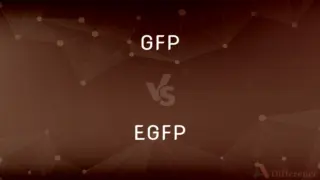Pooling of Interest Method vs. Purchase Method — What's the Difference?
Edited by Tayyaba Rehman — By Fiza Rafique — Published on December 12, 2023
Pooling of Interest Method combines companies treating them as equals, while Purchase Method treats one company as the buyer and the other as the purchased.

Difference Between Pooling of Interest Method and Purchase Method
Table of Contents
ADVERTISEMENT
Key Differences
The Pooling of Interest Method is an accounting method used for the merger or consolidation of companies. This approach treats the combining companies as equals without any exchange of cash. Under this method, both entities' assets and liabilities are combined without any adjustments to fair market values. The Purchase Method, conversely, views one company as the "buyer" and the other as the "purchased." This method involves one company acquiring another, with the purchasing company recording the acquired assets and liabilities at their fair market values.
Essentially, while the Pooling of Interest Method sees both companies as joining forces without monetary considerations, the Purchase Method factors in the purchase price and related financial adjustments.
Both the Pooling of Interest Method and Purchase Method serve to present a clear financial picture post-merger, but their approaches and implications differ considerably.
Lastly, while the Purchase Method remains prevalent in contemporary accounting, the Pooling of Interest Method has been phased out by many standards.
Comparison Chart
Treatment of Companies
Combines companies as equals
One company as buyer, the other as purchased
ADVERTISEMENT
Purchase Price Consideration
No purchase price involved
Purchase price is a key consideration
Asset & Liability Valuation
Combined without fair market value adjustments
Recorded at fair market values
Monetary Exchange
No cash exchange
Likely involves cash or other monetary considerations
Modern Usage
Phased out by many standards
More prevalent and accepted in modern accounting
Compare with Definitions
Pooling of Interest Method
Pooling of Interest Method: Combines assets and liabilities without adjustments.
Under the Pooling of Interest Method, the financial statements were simply aggregated.
Purchase Method
Involves one company buying another.
The company used the Purchase Method to account for the acquisition.
Pooling of Interest Method
Pooling of Interest Method: Merges companies as equals.
The merger proceeded using the Pooling of Interest Method, treating both firms equally.
Purchase Method
Assets and liabilities recorded at fair market values.
The Purchase Method required them to adjust assets to their current market prices.
Pooling of Interest Method
Pooling of Interest Method: Previously common for merger accounting.
Historically, many mergers preferred the Pooling of Interest Method for simplicity.
Purchase Method
Purchase price is central to accounting.
Using the Purchase Method, they factored in the acquisition cost prominently in records.
Pooling of Interest Method
Pooling of Interest Method: No cash exchange in consolidation.
Using the Pooling of Interest Method, they avoided any exchange of cash during the merger.
Purchase Method
Common in modern accounting for mergers.
In contemporary scenarios, the Purchase Method remains the preferred approach for acquisitions.
Pooling of Interest Method
Pooling of Interest Method: Lacks adjustments to fair market values.
The Pooling of Interest Method kept the original book values intact for the merger.
Purchase Method
Reflects the financial reality of an acquisition.
Adopting the Purchase Method presented a clearer financial picture post-acquisition.
Common Curiosities
Does the Pooling of Interest Method involve a cash exchange?
No, the Pooling of Interest Method doesn't involve any cash exchange.
Is the Purchase Method still widely used?
Yes, the Purchase Method remains prevalent in modern accounting.
Does the Purchase Method always involve cash transactions?
Not necessarily, but it does factor in the purchase price and financial adjustments.
Are assets adjusted to market value in the Pooling of Interest Method?
No, assets are combined without adjustments to fair market values.
How does the Purchase Method represent acquired assets?
It records assets and liabilities at their fair market values.
Which method gives a clearer post-merger financial picture?
The Purchase Method provides a more transparent reflection of financial realities post-acquisition.
Are there tax implications for choosing one method over the other?
Yes, tax treatments can vary depending on the method and jurisdiction.
What's the main distinction between the Pooling of Interest Method and Purchase Method?
Pooling treats companies as equals, while Purchase sees one company buying another.
Why has the Pooling of Interest Method been phased out?
It lacks the financial clarity and adjustments that modern accounting standards prefer.
Can a company choose between the two methods at will?
No, the choice is governed by accounting standards and regulations.
Can the Pooling of Interest Method be used for international mergers?
It depends on accounting standards; however, many have phased out its use.
Does the Purchase Method require revaluation of all assets?
Yes, assets and liabilities are recorded at their current fair market values.
Which method offers a more detailed breakdown of acquisition costs?
The Purchase Method provides a detailed representation, including goodwill calculations if applicable.
How do goodwill calculations differ between the two methods?
Goodwill arises in the Purchase Method if the purchase price exceeds the fair market value of net assets.
Why might a company prefer the Pooling of Interest Method historically?
It was simpler, without needing to adjust assets and liabilities to market values.
Share Your Discovery

Previous Comparison
GFP vs. EGFP
Next Comparison
National Holiday vs. Federal HolidayAuthor Spotlight
Written by
Fiza RafiqueFiza Rafique is a skilled content writer at AskDifference.com, where she meticulously refines and enhances written pieces. Drawing from her vast editorial expertise, Fiza ensures clarity, accuracy, and precision in every article. Passionate about language, she continually seeks to elevate the quality of content for readers worldwide.
Edited by
Tayyaba RehmanTayyaba Rehman is a distinguished writer, currently serving as a primary contributor to askdifference.com. As a researcher in semantics and etymology, Tayyaba's passion for the complexity of languages and their distinctions has found a perfect home on the platform. Tayyaba delves into the intricacies of language, distinguishing between commonly confused words and phrases, thereby providing clarity for readers worldwide.












































